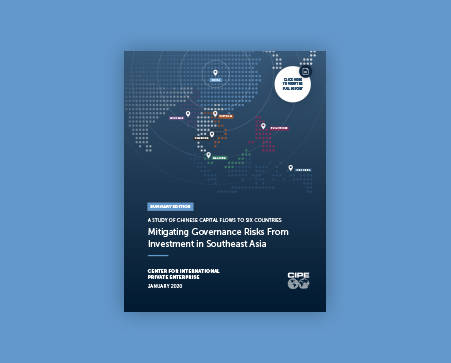A Study of Chinese Capital Flows to Six Countries

Economic development and growth are fueling outbound capital flows from the People’s Republic of China (PRC) to global destinations. One region in particular has become a prominent recipient of Chinese capital: Southeast Asia. Geographic proximity, economic complementarity and China’s Belt and Road Initiative (BRI) are factors that have led to high levels of foreign direct investment (FDI) and other investments—such as development aid—flowing from China to numerous Southeast Asian states.
Emerging economies typically strive to attract FDI to stimulate economic growth. Yet while FDI does bring benefits to recipient countries, it can also expose weaknesses in procurement and governance practices, foster corruption and rent-seeking behavior, and cause environmental degradation. The chapters in this report summarize lengthier papers authored by experts based in Southeast Asian states, and reveal some common themes across a diverse swath of industries and countries to which Chinese capital has flowed.
All countries covered in this report have found that Chinese FDI and other investments can expose shortcomings in governance pertaining to procurement, the management of public-private partnerships, and labor and environmental regulations. While nations such as Malaysia and Indonesia can benefit from Chinese-funded infrastructure projects, their weak regulations and less-than-honest officials encouraged opacity and corruption. Such misconduct was put on display most famously in Malaysia’s East Coast Rail Link project, whose cost was allegedly inflated to shield former Prime Minister Najib Razak’s corruption scandal associated with the 1Malaysia Development Berhad, or 1MDB.
Most countries in this study also suffered negative environmental and labor market consequences as a result of Chinese capital inflows. While Chinese contractors and funders are often to blame, weak or poorly enforced environmental, labor and immigration regulations in countries such as Indonesia, Vietnam, the Philippines and Myanmar are also causes. Finally, governments in nations such as Cambodia and the Philippines have at times actively courted Chinese investment, or weakened existing constraints on capital inflows, leading to negative consequences for the local economy.
The encouraging news is that non-governmental organizations, civil society and government agencies in many Southeast Asian countries have demonstrated resilience, and have been working to blunt the deleterious effects of Chinese capital inflows. Myanmar has implemented a mechanism to increase the transparency of public-private partnerships, and Indonesia has worked to push legislation to enhance data privacy.
Each chapter’s author(s) have proposed recommendations tailored to local conditions to help maximize the benefits of Chinese and foreign capital inflows while minimizing risks. These recommendations range from centralizing national oversight of foreign investment, to establishing new environmental standards.
Published Date: June 03, 2020
